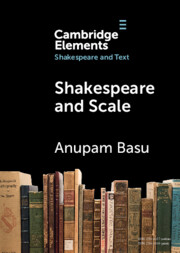Refine search
Actions for selected content:
95 results

The London Foundling Hospital and Eighteenth-Century Objects of Charity
- Recovering the Digital Archive
-
- Published online:
- 16 December 2025
- Print publication:
- 31 January 2026
-
- Element
-
- You have access
- HTML
- Export citation
Chapter 3 - Einstein on the Beach
-
- Book:
- American Performance in 1976
- Published online:
- 27 November 2025
- Print publication:
- 11 December 2025, pp 156-214
-
- Chapter
- Export citation
1 - Introduction
-
- Book:
- Negotiating Imperialism
- Published online:
- 08 November 2025
- Print publication:
- 20 November 2025, pp 5-38
-
- Chapter
-
- You have access
- Open access
- HTML
- Export citation

Moral Autopsy
- Truths, Secrets, and the Judicial Afterlives of Communist Secret Service Archives
-
- Published online:
- 18 November 2025
- Print publication:
- 30 October 2025
4 - Naming the Secret Communist Agent
- from Part II - In the Court of Law
-
- Book:
- Moral Autopsy
- Published online:
- 18 November 2025
- Print publication:
- 30 October 2025, pp 162-186
-
- Chapter
- Export citation
Archival Patchwork: Stitching Social Relationships in Colonial South Africa
-
- Journal:
- History in Africa , First View
- Published online by Cambridge University Press:
- 07 October 2025, pp. 1-18
-
- Article
-
- You have access
- Open access
- HTML
- Export citation
How and Why the Quyllurit’i Pilgrimage Is Related to the Tupac Amaru Rebellion
-
- Journal:
- Latin American Research Review ,
- Published online by Cambridge University Press:
- 16 September 2025, pp. 1-19
-
- Article
-
- You have access
- Open access
- HTML
- Export citation
Chapter 2 - Logbooks
-
- Book:
- Maritime Relations
- Published online:
- 23 August 2025
- Print publication:
- 04 September 2025, pp 60-100
-
- Chapter
- Export citation
Chapter 26 - Documentation
- from Part IV - Legacy
-
-
- Book:
- María Irene Fornés In Context
- Published online:
- 27 August 2025
- Print publication:
- 07 August 2025, pp 298-307
-
- Chapter
- Export citation
Chapter 10 - The First Filipino and the Archive
- from Part III - Transgressing
-
-
- Book:
- Latinx Literature in Transition, 1444–1886
- Published online:
- 06 August 2025
- Print publication:
- 17 July 2025, pp 231-251
-
- Chapter
- Export citation
Notes on the Difficulty of Studying State Archives in Egypt
-
- Journal:
- Comparative Studies in Society and History / Volume 67 / Issue 4 / October 2025
- Published online by Cambridge University Press:
- 07 July 2025, pp. 785-810
-
- Article
-
- You have access
- Open access
- HTML
- Export citation
African History and the Thingly Past: A Yoruba Example
-
- Journal:
- History in Africa , First View
- Published online by Cambridge University Press:
- 16 June 2025, pp. 1-19
-
- Article
- Export citation
The Underground Lives of Texts: Lamine Senghor’s La Violation d’un pays from Interwar France to Senegal’s Decolonization
-
- Journal:
- African Studies Review / Volume 68 / Issue 3 / September 2025
- Published online by Cambridge University Press:
- 14 May 2025, pp. 533-556
-
- Article
- Export citation
Chapter 3 - Saving the Diary
-
- Book:
- The Strange History of Samuel Pepys's Diary
- Published online:
- 24 April 2025
- Print publication:
- 24 April 2025, pp 48-63
-
- Chapter
- Export citation

Shakespeare and Scale
- The Archive of Early Printed English
-
- Published online:
- 31 March 2025
- Print publication:
- 24 April 2025
-
- Element
- Export citation
8 - An Anthropologist among Ottomanists
- from Part I - Sources and Structures
-
-
- Book:
- The Cambridge Companion to Ottoman History
- Published online:
- 31 May 2025
- Print publication:
- 20 March 2025, pp 117-130
-
- Chapter
- Export citation
Human Rights ‘Fact’ Production and Why It Matters: Myanmar as a Case in Point
-
- Journal:
- Asia-Pacific Journal / Volume 20 / Issue 18 / October 2022
- Published online by Cambridge University Press:
- 14 March 2025, e6
-
- Article
-
- You have access
- Open access
- Export citation
Law and History in Angola: The Collection of Court Cases in the Benguela District Court (1850–1945)
-
- Journal:
- History in Africa / Volume 51 / May 2024
- Published online by Cambridge University Press:
- 10 February 2025, pp. 45-73
-
- Article
-
- You have access
- HTML
- Export citation
A Short Report on the Ghana Railway Archive in Sekondi-Takoradi
-
- Journal:
- History in Africa / Volume 51 / May 2024
- Published online by Cambridge University Press:
- 30 January 2025, pp. 203-210
-
- Article
-
- You have access
- Open access
- HTML
- Export citation
The materialised temporality of dust: developing a biodesign methodology to spatialise time and temporalise space
-
- Journal:
- Research Directions: Biotechnology Design / Volume 3 / 2025
- Published online by Cambridge University Press:
- 27 January 2025, e4
-
- Article
-
- You have access
- Open access
- HTML
- Export citation
